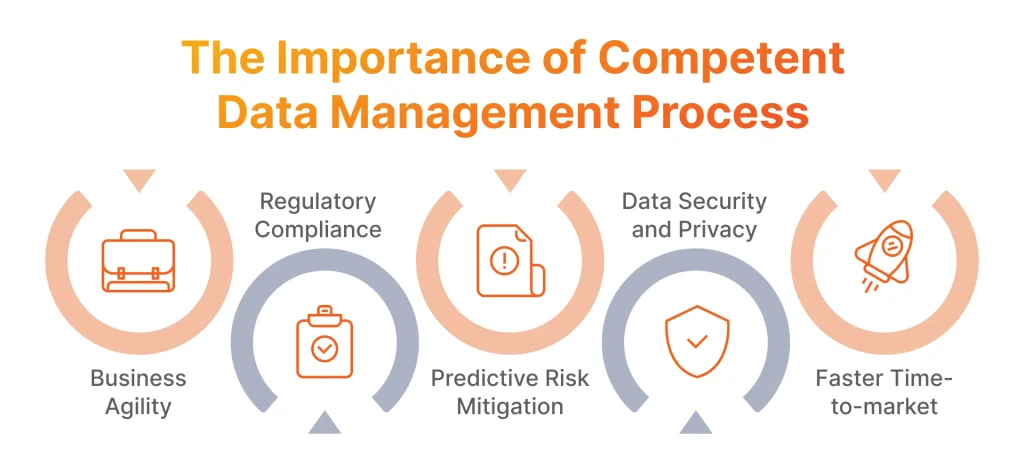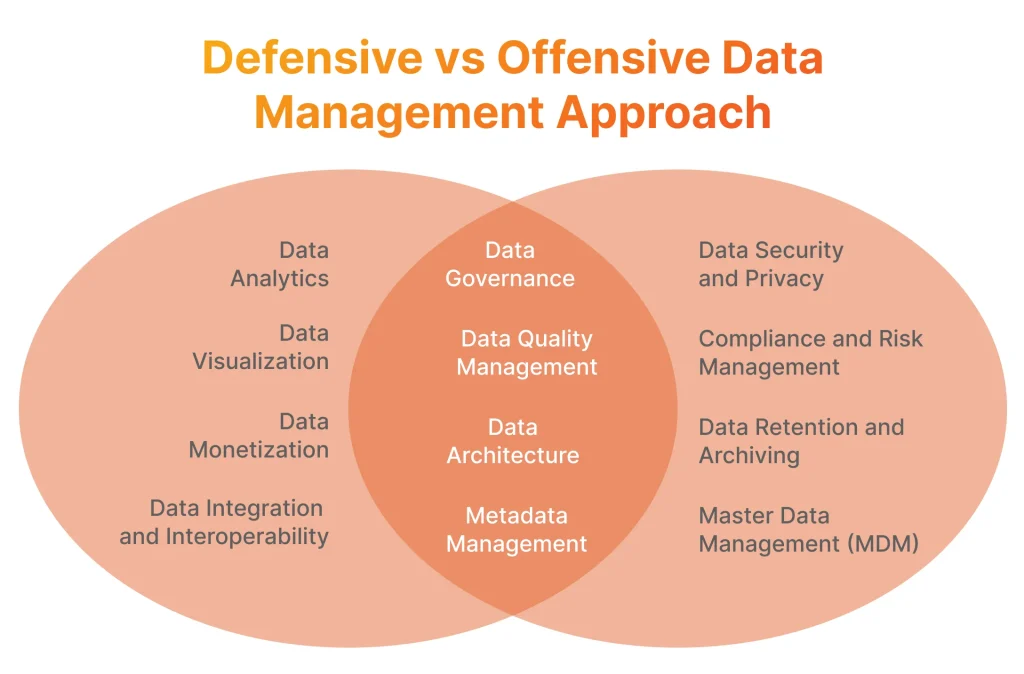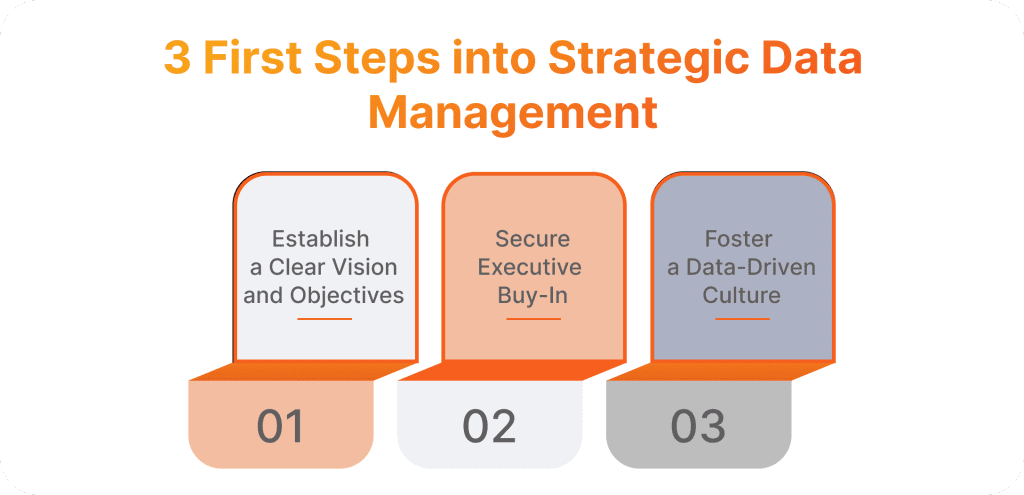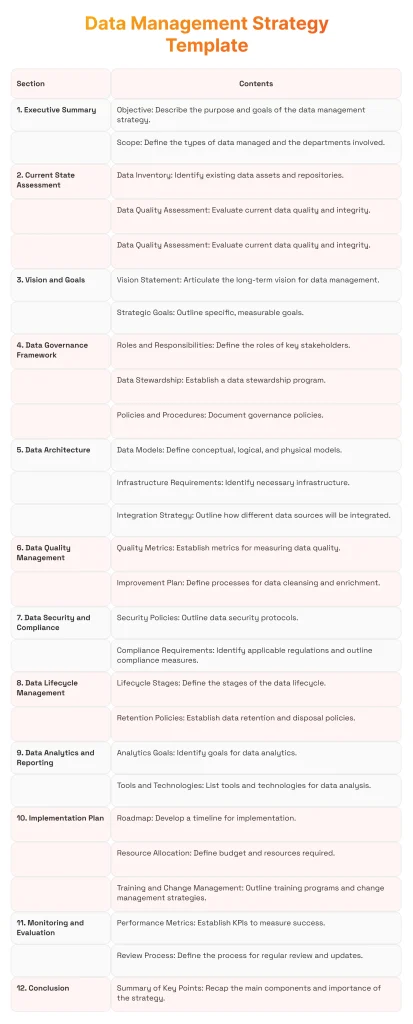Most organizations – 80% – will fail to scale their digital business by 2025 due to an outdated approach to data and analytics governance. A similar share of companies, 82%, still leverage stale data in decision-making, which leads to incorrect decisions and lost revenue.
Developing a data management strategy is key to unlocking the full potential of your data. It’ll ensure you manage your data consistently, aligning it with your business needs across the whole organization.
Let’s discover what a data management strategy is, what it should include, and how to avoid potential pitfalls with its development based on our experience.
Why Competent Data Management Process Matters
Before we move on to the data management strategy, let’s break down why it’s important to set up your data management process right. In a nutshell, a strategic, expertise-driven approach to building and maintaining data management processes turns your data into a valuable asset in the long run.

High-quality, up-to-date data available exactly when needed enables wiser decision-making, operational efficiencies, and better employee and customer experiences. Over time, a comprehensive data management strategy also ensures:
- Business agility: Reliable real-time data analytics allow you to make smart decisions fast. This improves the organization’s ability to adapt to market conditions, and competitor and regulatory landscape changes.
- Regulatory compliance: Protecting sensitive data, logging data collection and use, and deleting unneeded data are the cornerstones of compliance with regulations like GDPR and CCPA.
- Predictive risk mitigation: Running what-if scenarios using predictive models and historical data informs better risk assessment, prioritization, planning, and mitigation.
- Data security and privacy: Data management ensures security and privacy practices are consistently followed to prevent data breaches and accidental exposure.
- Faster time-to-market: A modern approach to data management ensures your infrastructure remains flexible enough to implement advanced capabilities promptly.
What Is a Data Management Strategy?
In layman’s terms, a data management strategy is a document that outlines how your organization will manage its data across functions to achieve specific goals. It ensures a coherent, consistent approach to managing data throughout its lifecycle, from collection to deletion, and maximizes the data’s reliability, usefulness, and ease of governance.
A robust data management strategy allows you to lay the foundation for deriving powerful insights from your data, improving its ROI while reducing its TCO, and maximizing the business impact of Big Data and AI/ML.
A data management strategy isn’t the same as a data management framework. The framework outlines the context and principles of data management; it serves as the foundation for the strategy. The strategy, in turn, is more concrete and comprehensive than the framework; it defines goals, priorities, and required capabilities and resources.
So, first, you have to define the framework, and then use it to develop the data management strategy. Based on the strategy, you will be able to devise the data management roadmap for implementing the strategy in practice.
Defensive vs Offensive Data Management Approach
Before you start developing your strategy, you should choose between these two distinct approaches to data management:
- Defensive strategy focuses on mitigating risks and preventing negative outcomes through addressing compliance, governance, and security.
- Offensive strategy prioritizes achieving positive outcomes, such as revenue increase or improved CX, with objectives relating to a specific product or line of business.

Dmytro Tymofiiev
Delivery Manager at SPD Technology
“Choosing the methodology isn’t necessarily an either-or choice. You can and should combine both approaches in your strategy, with one perhaps emphasized over the other. Keep in mind, however, that you’ll have to make trade-offs when prioritizing offensive or defensive investments.”
Shared and Unique Components of Defensive vs Offensive Approaches to Managing Data
Defensive and offensive data management approaches both include provisions on data governance, data quality management, data architecture, and metadata management. Beyond that, however, they focus on different aspects of managing enterprise data:
- Offensive data management prioritizes data analytics, data visualization, data monetization, and data integration and interoperability to achieve positive business outcomes.
- Defensive data management emphasizes data security and privacy, compliance and risk management, data retention and archiving, and master data management (MDM).
What Is the Defensive Data Management Methodology?
The defensive methodology approaches data management through the lens of mitigating risks, maintaining compliance, and ensuring data security and privacy. A defensive strategy includes the following components:
- Data security and privacy: Protecting data from unauthorized access, modification, or deletion and enabling control over personal data
- Compliance and risk management: Implementing the necessary measures, processes, and roles to maintain compliance and mitigate risks regarding data privacy, security, and accuracy
- Data retention and archiving: Archiving the data no longer needed for daily operations and deleting data after a specific time window
- Master data management (MDM): Creating and maintaining a single master record for specific entities (customers, products, locations, etc.).
What Is the Offensive Data Management Methodology?
The offensive methodology prioritizes using data to improve services and products, enhance CX, gain competitive advantages, improve decision-making, and drive revenue, profits, and business growth.
Based on these priorities, the offensive strategy contains the following components:
- Data analytics: Collecting, preparing, and supplying data to BI and advanced analytics tools
- Data visualization: Enabling business users to visualize data with graphs, charts, and dashboards
- Data monetization: Sharing data securely with selected third parties to generate an additional revenue stream
- Data integration and interoperability: Ensuring the compatibility of data models across software systems to enable a seamless flow of data.

Balancing Offensive and Defensive Data Management
As no organization’s resources are infinite, you must decide which trade-offs are acceptable. That depends on your regulatory constraints, market conditions, and business priorities.
For example, hospitals operate in a highly regulated sector where data security, privacy, and quality are of utmost importance. So, they’ll benefit from a focus on the defensive approach. Retailers, on the other hand, don’t have to handle as much sensitive data or comply with as many strict regulations. So, focusing on the offensive strategy components is usually a more suitable choice for them.
Regardless of the approach you prioritize, however, your strategy should include:
- Data governance: Establishing roles, structures, and processes for managing data assets (e.g., data ownership, data standards, auditing procedures)
- Data quality management: Defining data quality standards, transforming data to enforce them, and monitoring and validating data quality
- Data architecture: Outlining how data is managed from collection and transformation to distribution and consumption
- Metadata management: Collecting, curating, and analyzing comprehensive data about data to improve its quality and relevance.
5 Types of Data Covered by Data Management Strategies
To align your enterprise data strategy with the operational needs of all business functions and gain maximum visibility into your operations, make sure you address these five data types.

Master Data
Master data consists of fundamental data entities that serve as the point of reference for multiple processes and operations across the organization. It’s stable, unique, consistent, and cross-functional. It’s also integrated into multiple systems and has a longer lifespan than transactional data. Master data typically includes data about customers, employees, partners, suppliers, products, services, and locations. For example, it can include product SKUs, supplier codes, and customer names. The lack of a master data management strategy may result in teams relying on information that doesn’t get properly synced. For example, if a customer’s phone number changes, a marketing team might see it in its database, but the sales team won’t automatically gain access to it.
Metadata
Metadata is the data about data; it describes the said data. Common metadata fields include size, time created or modified, authorship, source, and more. Metadata can be broken down into five categories: descriptive, use, administrative, provenance, and structural data. Proper metadata management allows you to capture the relationships between data, make it more searchable, and improve data quality and analytics. It’s also crucial for robust data governance and compliance.
Transactional Data
Transactional data is the data generated as a result of a specific transaction or event. For example, it can include data about a recent sale: the customer ID, what they bought, how much they paid, and which payment method they used. Transactional data is granular, dynamic, time-sensitive, and temporary. It also relies on material data to provide context (e.g., customer information). This type of data is critical for real-time decision-making and up-to-minute analytics. It can also reflect the current trends in transaction volumes and other operations, allowing businesses to quickly adapt to changing circumstances.
Operational Data
Operational data concerns the day-to-day operations of your organization and is available as soon as it’s generated or acquired. It can include the location of a specific asset or inventory item or purchase order fulfillment status, for example. Combined with analytics tools, operational data can help you optimize logistics, manage product availability and inventory, and track order statuses. Ultimately, operational data is key to unlocking operational efficiencies and removing bottlenecks.
Analytical Data
Analytical data is the data used for strategic decision-making within an organization. It’s the historical data that analytics tools rely on when producing output, typically stored in read-only databases. It can include the company’s financial performance, conversion rates for different sales channels, or market environment variables. Quality analytical data allows you to minimize statistical error and derive reliable insights into historical data to inform strategic decision-making.
Strategic Data Management: 3 Steps Before You Start
Before you can develop a data management strategy, you need to prepare your organization for this strategic shift. Let’s discover the three steps for laying the foundation for your new approach to data management.

Establish a Clear Vision and Objectives
What are you striving to achieve with your data management strategy? This is the question you should discuss with key stakeholders to settle on the strategic data management objectives. They can include improvements in operational efficiency, customer insights, or decision-making, for example.
The vision, in turn, describes your target operating state: how the data will be collected, protected, governed, managed, used, and deleted. Once you define the goals and vision for your strategy, communicate it with stakeholders to secure their support and ensure alignment.
Secure Executive Buy-In
Changing how your organization manages data is a strategic undertaking, so it can’t happen without involving senior executives. Bring them on board early on. If you don’t, you may fail to secure resources to see the project through or ensure the commitment required for an organization-wide change.
To secure the buy-in of senior leadership, demonstrate value from reaching the outlined goals by calculating the potential gains from strategic data management as opposed to costs. Focus on business use cases that will deliver quick wins.
Foster a Data-Driven Culture
Implementing a data management strategy will require a cultural shift, and resistance to change can easily undermine your efforts. So, promote cross-departmental collaboration and encourage teams to prioritize data and insights to innovate and improve business outcomes.
Fostering a data-driven culture also means equipping business users with data literacy skills. Data literacy skills enable employees to use data responsibly and leverage it to make better decisions in daily work. Promoting data literacy means investing in training programs to teach business users how to use, understand, and communicate data.

Dmytro Tymofiiev
Delivery Manager at SPD Technology
“As with any cultural shift, you should lead by example if you strive to build a data-driven culture. Ensure the senior leadership relies on data when making decisions, communicates data-driven insights, and collaborates across the departmental lines.”
Data Management Strategy Template
With the goals outlined, senior executives’ buy-in secured, and the shift to a data-driven culture put into motion, you can get to developing the data management strategy itself. Here’s the template you may follow.

Data Management Strategy Development Pitfalls to Avoid
The quality, accuracy, and alignment of your data management strategy will impact its implementation – and determine whether you’ll be able to achieve the stated goals. That said, there is a chance to overlook some pitfalls, especially if you are at the beginning of your journey to competent data management.
As a data management consulting partner with almost two decades of experience, we, at SPD Technology, are well-acquainted with these pitfalls, so we suggest breaking them down into two broad categories: business pitfalls and technical ones. Let’s discover what each of them entails – and how we help our clients avoid those issues.
Business Pitfalls
Business pitfalls, as the name suggests, occur on the business side of the project. Failing to counter them can lead to poor ROI, inefficient resource allocation, compliance and quality issues, and subpar user engagement.
Lack of Executive Buy-In
Failing to secure the support of executive leadership can leave data management initiatives without proper funding and resources. A lack of a strategic commitment at the top also usually undermines the push for a data-driven culture and stands in the way of aligning the strategy with business goals.
How We Address It: We organize workshops for senior executives to identify and align strategy goals with business priorities. These workshops take place early on to secure the buy-in and resources for the strategy implementation and avoid misalignment.
Unclear Objectives
Ambiguous goals and poorly defined KPIs mean you may dedicate your limited resources to the wrong initiatives, tools, or processes. If that happens, you won’t be able to derive the expected value from the project and obtain the desired outcomes.
How We Address It: We invest our time and effort into conducting thorough interviews and assessments. Their results allow us to establish clear business goals and define data management objectives accordingly.
Neglecting Data Governance
Overlooking this strategy component can lead to poor data quality, inconsistencies in data use, and realized compliance risks. Without robust data governance, decision-makers may not be able to trust the available data, either.
How We Address It: We establish a data governance framework early on, including the data ownership and accountability roles, responsibilities, and policies. You can learn more about our approach to data governance from our data strategy development for a P2P lending company case study.
Ignoring User Needs
If the implemented tools and processes don’t meet the needs of end users, they’re likely to avoid using those tools or complying with established procedures. So, you’re risking the rise of shadow IT, poor engagement, and lack of the expected ROI.
How We Address It: We discuss data needs and challenges with end users during the discovery phase to ensure their requirements are taken into account. This approach ensures better engagement and secures the buy-in at every level of the organization.
Want to take a deeper dive into the specifics of data management at the enterprise level?
Check out our guide on enterprise data management!
Technical Pitfalls
Technical pitfalls are the common mistakes made during architecture planning and process design. They can stem from a lack of relevant technical expertise or a failure to align the solution with business requirements. These pitfalls can lead to bottlenecks, slow performance, lack of scalability, unreliable analytics output, flawed decision-making, and more. Below are the most critical ones.
Inadequate Data Quality Assessment
Roughly one in two data and analytics leaders don’t have complete faith in their data’s accuracy. That’s a direct result of subpar data quality, which can lead to flawed operational and strategic decision-making.
How We Address It: We identify and resolve key data quality issues before implementing the strategy. We also ensure the established data quality standards and processes align with business needs to enable data reliability, accuracy, timeliness, and fitness for purpose.
Don’t know how to ensure the reliability of your data?
Read our guide on data quality management to discover its key principles and pitfalls to avoid.
Insufficient Infrastructure Planning
Poorly designed data infrastructure can lead to issues in performance and scalability while handling the increasing data volumes remains a top three barrier to achieving data management goals for 77% of organizations. In addition to scalability issues, insufficient infrastructure planning can lead to integration problems, increased costs, and security risks. Together, they weaken an enterprise’s ability to effectively manage and use its data, so it is necessary to assess the infrastructure needs and plan for future growth already at the stage of data management strategy development.
How We Address It: We evaluate the existing data infrastructure and compare it against future data needs. Based on our assessment, we recommend highly scalable solutions that match current and future requirements, such as an enterprise data warehouse or data lake. We also help our clients move to the cloud to reap the cloud computing infrastructure benefits.
Poor Integration Strategies
Overlooking the importance of data integration can lead to data silos, which will hinder access to data both for business users and analytics and BI tools. As a result, you may struggle with visibility into data collection and use, and analytics tools may not produce accurate results.
How We Address It: We prioritize seamless integration based on existing systems and workflows, as well as the opportunities and constraints they present. Our approach to data integration ensures optimal data timeliness and availability across the organization.
Neglecting Security and Compliance
Failing to pay enough attention to security and compliance puts your organization at a higher risk of accidental exposure, data breaches, and non-compliance. Apart from the financial losses following a breach or regulator’s investigation, you may suffer reputational losses and undermine customer trust.
How We Address It: We assess security and compliance risks to ensure the data management strategy includes the most suitable measures and provisions to secure data and maintain compliance. As a result, we ensure adherence to applicable regulations and protect sensitive data from malicious intent and accidental exposure.
Data Management Project Strategy Development and Implementation: SPD Technology’s Experience
Avoiding these and other pitfalls requires solid experience and technical expertise in data management. This is where one of the key advantages of strategic technology consulting lies: it provides you access to the required expertise without the drudgery of in-house recruitment.
As a trusted provider of data management services, we, at SPD Technology, have the real-world experience and technical skills to deliver and implement a data management strategy that maximizes the ROI of your data and becomes a long-term value-driving asset.
For example, we helped Pie Insurance, a U.S.-based SME employee insurance company, grow an average check by 30% with a feature-rich billing platform. Pie Insurance turned to us with a request to replace a third-party legacy billing platform that was too cumbersome and hindered the company’s growth.
Besides delivering a custom billing system, we also developed an operational data management application to aggregate data from disparate sources into a single system, which included:
- ETL pipeline to consolidate data from multiple systems
- Data cleansing processes to ensure data quality and consistency
- Automatic frequent refreshing to keep data up-to-date.
Through our comprehensive data management solutions, we empowered Pie Insurance to support its growing business needs and improve customer satisfaction.
Conclusion
A robust, comprehensive data management strategy will enable your organization to make smarter decisions, maintain compliance, enhance risk management, and boost operational efficiency.
However, developing this strategy shouldn’t be taken lightly. It requires a complete understanding of how your business needs translate into technical requirements. You also need to be mindful of multiple pitfalls that may undermine the strategy’s success, from unclear objectives to poorly planned infrastructure.
That’s why partnering with a reliable vendor for data management strategy development would be the right choice. SPD Technology’s experts can help you assess your needs, translate them into specific policies and measures, and deliver technical solutions to enable them. Discover our data management consulting services to learn more about what we can do for you.
FAQ
What is a data management strategy?
A data management strategy is a document that outlines the organization-wide approach to collecting, storing, and using data to achieve specific goals. Two main approaches to the strategy are: offensive, which prioritizes driving positive outcomes, and defensive, which focuses on mitigating risks and maintaining compliance and security.
How to create a data management strategy?
To create a data management strategy:
- Assess the current data inventory, quality, and compliance
- Describe the vision and goals
- Establish the data governance framework
- Outline the data architecture
- Describe data quality management metrics and improvement plan
- Establish data security policies and compliance requirements
- Describe data lifecycle stages and retention policies
- Outline data analytics and reporting goals and tools
- Develop the implementation plan
- Define performance metrics and review processes.

